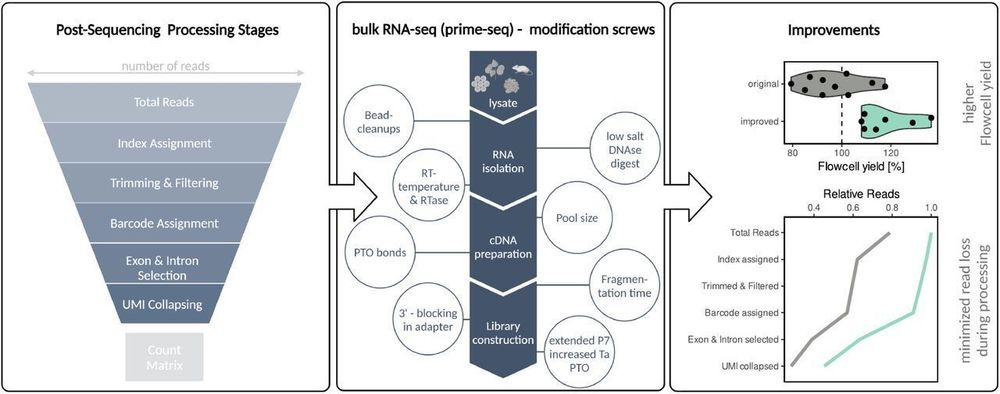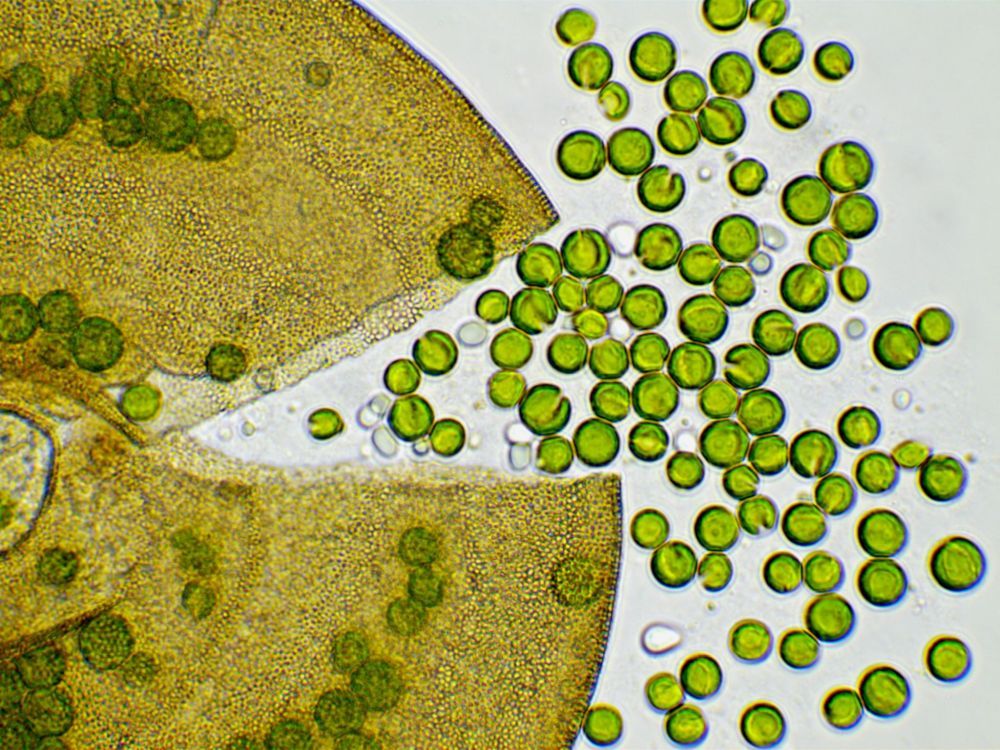
Pretty excited to share our new preprint!
Non-photosynthetic Plastid Replacement by a Primary Plastid in the Making
www.biorxiv.org/content/10.1...
@fburki.bsky.social
Exploring the great microbial eukaryote diversity and evolution, one protist at a time. I’m fascinated by this question: how have #plastids evolved? #ProtistsOnSky | Associate Prof at Uppsala University. My lab: https://www.burki-lab.net/

Pretty excited to share our new preprint!
Non-photosynthetic Plastid Replacement by a Primary Plastid in the Making
www.biorxiv.org/content/10.1...

A new preprint from us using a single-cell genome pipeline to investigate diversity of uncultured Bodo spp. flagellates.
We isolated 7 Bodo spp. cells from a single environmental sample and show that they represent 3 Bodo sp. each with a unique species of bacterial endosymbiont. #protistsonsky

Researchers present the BaNaNA (Barcoding Nanopore Neat Annotator) pipeline and display the effectiveness of long-read Nanopore sequencing for protist biodiversity, ecology and evolution research.
🔗 doi.org/10.3897/mbmg...
@ankarn.bsky.social @fabnot.bsky.social
I wish these were my areas of expertise, look at this place
07.10.2025 10:30 — 👍 1 🔁 0 💬 1 📌 0
Our latest, led by Edu Ocaña-Pallarès and @ssolo.bsky.social, a timescale for fungal phylogeny that wrangles calibration from the unstructured fossil record of fungi and a history of horizontal gene transfers
www.nature.com/articles/s41...

Improving RNA-seq protocols www.biorxiv.org/content/10.1...
07.10.2025 07:00 — 👍 0 🔁 1 💬 0 📌 0
Latest from ours: www.cell.com/cell-reports...
This is two stories in one: a case study/cautionary tale on developing genetic tools in new organisms, and the first hint at a gene regulatory network for choanoflagellate multicellular development (which turn out to involve a Hippo/YAP/ECM loop!) A 🧵

I've seen this several times: when Acantharians get big enough they like to eat tintinnids. And they always orient with the lorica opening pointed in: like they are slurping up a little jello shot. That glass house can't protect you from these weird predators little ciliate! 🦑 #protistsonsky
02.10.2025 19:46 — 👍 47 🔁 9 💬 2 📌 0
Study reveals the hidden genomic diversity & global distribution of Phaeocystales — bloom-forming algae with surprising mixotrophic strategies, viral integrations, & adaption to polar vs temperate zones. #protistsonsky
Big step forward for marine ecology & biogeochemical models. 🧬🌊
📖 rdcu.be/eI4nv

A New Age of Advanced Volume Microscopy for Protists onlinelibrary.wiley.com/doi/10.1111/... #protists #protistsonsky
01.10.2025 16:02 — 👍 21 🔁 6 💬 1 📌 0
Eukaryogenesis From FECA to LECA: Radical Steps Along the Way onlinelibrary.wiley.com/doi/10.1002/...
01.10.2025 02:15 — 👍 3 🔁 1 💬 0 📌 0Very true. The time it takes to gain energy back after teaching a class is often not properly factored in
30.09.2025 12:04 — 👍 1 🔁 0 💬 0 📌 0#ProtistsOnSky
the elephant in the (protist)room...
I have thousands of #marineplankton microscopy images and measurements and would like to make these available to researchers. Where’s the best place to put them and how do scientists like their metadata? 🧪🦑
28.09.2025 08:36 — 👍 17 🔁 8 💬 1 📌 0#protistsonsky
27.09.2025 07:04 — 👍 6 🔁 0 💬 0 📌 0
Evolutionary refinement of mitochondrial and plastid targeting sequences coincides with the late diversification of land plants academic.oup.com/mbe/article/...
24.09.2025 02:58 — 👍 1 🔁 2 💬 0 📌 0Are you a recent PhD interested in a postdoc in Canada? Up to 20% of NSERC Postdoc Fellowships (70k/y for 2y) will be awarded to International applicants, who did their PhD outside of Canada. Deadline is 17 October. See: www.nserc-crsng.gc.ca/Students-Etu...
20.09.2025 06:26 — 👍 17 🔁 19 💬 1 📌 1While it could have been a wild goose chase, finding this one is special to me because we were stacked against the odds
18.09.2025 16:25 — 👍 8 🔁 1 💬 0 📌 0
Comparative single-cell genomics of two uncultivated Naegleria species harboring Legionella cobionts journals.asm.org/doi/10.1128/... #protists #protistsonsky
16.09.2025 07:00 — 👍 7 🔁 2 💬 0 📌 0
Comparing the precision of two digital PCR applications for copy number comparisons in #protists www.nature.com/articles/s41... #protistsonsky
15.09.2025 16:02 — 👍 3 🔁 3 💬 0 📌 0These are good changes, especially this: B1 <<should allow the panels to answer the question “is this a great idea that would be worth pursuing?”, while the question for>> B2 <<is “can that idea be pursued realistically, and if so, in the manner and with the approach that the applicant proposes?”>>
15.09.2025 10:31 — 👍 0 🔁 0 💬 0 📌 0We have tried chemical fixation but this was not successful with these "bottle" cells, and we don't have easy access to cryo. @fmikus.bsky.social did plunge one of our cultures when we were at UBC, but I haven't heard how this went
12.09.2025 10:34 — 👍 2 🔁 0 💬 2 📌 0
www.science.org/doi/10.1126/...
#protistsonsky
What’s the scale?
11.09.2025 15:44 — 👍 0 🔁 0 💬 1 📌 0Expanding our Paulinella factory and hopefully more to come. @thealgaeman.bsky.social is the master grower, quite a tour de force for these very rare cells. @erc.europa.eu supported research
11.09.2025 09:23 — 👍 21 🔁 0 💬 1 📌 0

I broke some shells of Galeripora artocrea, to look at their algal hostages...and accidentally created Pac-Man amoebae. #amoebae #peatlands #ProtistsOnSky
08.09.2025 17:52 — 👍 60 🔁 8 💬 1 📌 0Could you briefly explain why is eRNA in principle more contamination-prone than eDNA? Thank you
10.09.2025 15:26 — 👍 0 🔁 0 💬 1 📌 0
What you're looking at is a brand new protist species! 🤯🔬
Isn't it beautiful?
This image is just a glimpse of what's to come. We can't wait to share our full findings soon, in partnership with Guifré @beaplab.bsky.social @luisjagago.bsky.social. Stay tuned! #NewSpecies #protistsonSky #diversity
#protistsonsky
10.09.2025 06:34 — 👍 8 🔁 0 💬 0 📌 0#protistsonsky
10.09.2025 05:04 — 👍 9 🔁 0 💬 1 📌 0